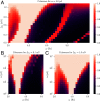Neural heterogeneity controls computations in spiking neural networks
- PMID: 38198531
- PMCID: PMC10801870
- DOI: 10.1073/pnas.2311885121
Neural heterogeneity controls computations in spiking neural networks
Abstract
The brain is composed of complex networks of interacting neurons that express considerable heterogeneity in their physiology and spiking characteristics. How does this neural heterogeneity influence macroscopic neural dynamics, and how might it contribute to neural computation? In this work, we use a mean-field model to investigate computation in heterogeneous neural networks, by studying how the heterogeneity of cell spiking thresholds affects three key computational functions of a neural population: the gating, encoding, and decoding of neural signals. Our results suggest that heterogeneity serves different computational functions in different cell types. In inhibitory interneurons, varying the degree of spike threshold heterogeneity allows them to gate the propagation of neural signals in a reciprocally coupled excitatory population. Whereas homogeneous interneurons impose synchronized dynamics that narrow the dynamic repertoire of the excitatory neurons, heterogeneous interneurons act as an inhibitory offset while preserving excitatory neuron function. Spike threshold heterogeneity also controls the entrainment properties of neural networks to periodic input, thus affecting the temporal gating of synaptic inputs. Among excitatory neurons, heterogeneity increases the dimensionality of neural dynamics, improving the network's capacity to perform decoding tasks. Conversely, homogeneous networks suffer in their capacity for function generation, but excel at encoding signals via multistable dynamic regimes. Drawing from these findings, we propose intra-cell-type heterogeneity as a mechanism for sculpting the computational properties of local circuits of excitatory and inhibitory spiking neurons, permitting the same canonical microcircuit to be tuned for diverse computational tasks.
Keywords: heterogeneity; mean-field models; neural computation; neural dynamics; recurrent neural networks.
Conflict of interest statement
Competing interests statement:The authors declare no competing interest.
Figures





References
-
- Abbott L. F., Sejnowski T. J., Neural Codes and Distributed Representations: Foundations of Neural Computation (MIT Press, 1999).
-
- Izhikevich E., Simple model of spiking neurons. IEEE Trans. Neural Netw. 14, 1569–1572 (2003). - PubMed
MeSH terms
Grants and funding
LinkOut - more resources
Full Text Sources

